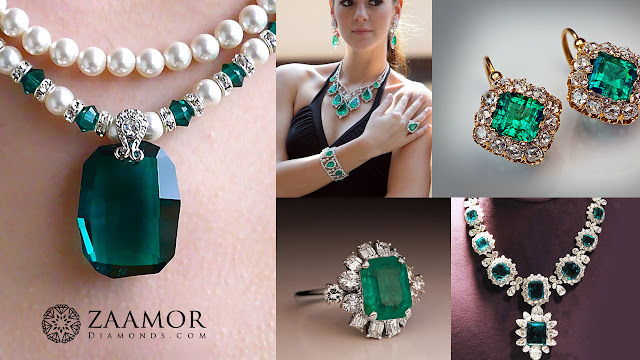Emerald is the birthstone for those who born in the month of May and anniversary stone for those completing 20th, 35th and 55th year ...
Emerald is the birthstone for those who born in the month of May and anniversary stone for those completing 20th, 35th and 55th year of marriage. Now the market is flooded with imitations, simulators and synthetic stones. To make the purchase of a true stone buyer needs awareness and information about this captivating gemstone.
Name Derivation:
Emerald, the name is derived from a French word ‘esmeraude’. This word had its origin from Latin and Greek word ‘smaragdos’ meaning green stone. It was discovered millions of years ago in the mines of Egypt known as Cleopatra Mines. Since then it is an important part of the jewelry. Every generation considered it as a valuable asset.
4C’s of Emerald
Emerald Color
Without a question, color is by far the most meaningful of the 4 C’s. What captivates you right away when you see an emerald is undoubtedly its color — either a vibrant, passionate color or a dull, limp color — or possibly somewhere in between.
The most desirable emerald colors are bluish green to pure green, with vivid color saturation and tone that’s not too dark. The most prized emeralds are highly transparent. Their color is evenly distributed, with no eye-visible color zoning.
Emerald Clarity
As with diamonds, emeralds with better clarity fetch a higher price at market. But that’s where the comparison ends. Whereas with diamonds there is a clear clarity grading scale with emeralds there is not.
The other major difference is that we expect to see inclusions (imperfections that lower the clarity grade) in about 99% of emeralds. In fact, when you don’t see inclusions, you need to be suspicious that the emerald is not natural.
Emerald Cut
As with diamonds, the cut of the emerald refers to its faceting, shape, width, and depth. Ideally, an emerald should be cut symmetrically with uniform facets that allow for Paramount color and brilliance. If cut too deeply, the light will escape on the side and the emerald will look dark.
If too shallow, the emerald will not appear brilliant since the light will be lost at the bottom of the stone. The rectangular or square step cut called “emerald cut” is thought to maximize the shape of the rough. This is the most common cut, and hence why the name “emerald cut” stuck, even when applied to other gemstones.
Emerald Carat
It contains vitreous luster. It is transparent to translucent in nature. The beauty of the stone is enhanced in large sizes. The carat weight suitable for jewelry items is between 0.5 -4 ctw. Gems beyond 4 carat weight are rare and priced very high. Rough more than 10 carat weight seldom occurs.
This treasured stone is valued on the basis of color, clarity and carat weight. More bright and intense the green color more is the price. Similarly with the increase in the carat weight, the cost of the stone would also increase and finally less flaws in the crystal more are the worth. Different permutations and combinations of these three Cs are available in the market, a buyer can select any of them depending upon their pockets.
Emerald Certification:
At the first glance, it is very difficult to distinguish between the natural and synthetic gems. However, it is not impossible. Buyers can identify the original stone in two ways. First, check for the inclusions. Man made stones consist very thin inclusions as compared with the naturally occurred stones. Secondly, the color of the synthetic stones in ultraviolet light would appear reddish while the color of genuine stones would remain same in every light source.








